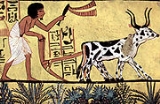
TT1
Encyclopedia
The Theban
Tomb TT1 is located in Deir el-Medina, part of the Theban Necropolis
, on the west bank of the Nile
, opposite to Luxor
. It is the burial place of the Ancient Egypt
ian official, Sennedjem
and his family.
The tomb was found in 1886 and was undisturbed. It contained over 20 burials, most of them certainly belonging to family members of Sennedjem. Sennedjem was placed in an outer box coffin with one inner human shaped one and a mummyboard. His wife Iyneferti had one human shaped coffin with a mummy board, while his son Khonsu was again placed in an outer box and one inner human shaped coffin, again with a mummy board. The wife of Khonsu was Tameket, placed into one coffin with a mummy board. For other people buried here the relation to Sennedjem is not clear. Burial goods included many shabtis, canopic boxes
and pieces of furniture. The objects were sold to several collections around the world; the most important items went to Cairo, New York and Berlin.
Thebes, Egypt
Thebes is the Greek name for a city in Ancient Egypt located about 800 km south of the Mediterranean, on the east bank of the river Nile within the modern city of Luxor. The Theban Necropolis is situated nearby on the west bank of the Nile.-History:...
Tomb TT1 is located in Deir el-Medina, part of the Theban Necropolis
Theban Necropolis
The Theban Necropolis is an area of the west bank of the Nile, opposite Thebes in Egypt. It was used for ritual burials for much of Pharaonic times, especially in the New Kingdom of Egypt.-Mortuary Temples:* Deir el-Bahri** Mortuary temple of Hatshepsut...
, on the west bank of the Nile
Nile
The Nile is a major north-flowing river in North Africa, generally regarded as the longest river in the world. It is long. It runs through the ten countries of Sudan, South Sudan, Burundi, Rwanda, Democratic Republic of the Congo, Tanzania, Kenya, Ethiopia, Uganda and Egypt.The Nile has two major...
, opposite to Luxor
Luxor
Luxor is a city in Upper Egypt and the capital of Luxor Governorate. The population numbers 487,896 , with an area of approximately . As the site of the Ancient Egyptian city of Thebes, Luxor has frequently been characterized as the "world's greatest open air museum", as the ruins of the temple...
. It is the burial place of the Ancient Egypt
Ancient Egypt
Ancient Egypt was an ancient civilization of Northeastern Africa, concentrated along the lower reaches of the Nile River in what is now the modern country of Egypt. Egyptian civilization coalesced around 3150 BC with the political unification of Upper and Lower Egypt under the first pharaoh...
ian official, Sennedjem
Sennedjem
The Ancient Egyptian artisan Sennedjem lived in Deir el-Medina on the west bank of the Nile, opposite Thebes, during the reigns of Seti I and Ramesses II. He was buried along with his wife, Iy-neferti, and family in a tomb in the village necropolis. His tomb was discovered January 31, 1886...
and his family.
The tomb was found in 1886 and was undisturbed. It contained over 20 burials, most of them certainly belonging to family members of Sennedjem. Sennedjem was placed in an outer box coffin with one inner human shaped one and a mummyboard. His wife Iyneferti had one human shaped coffin with a mummy board, while his son Khonsu was again placed in an outer box and one inner human shaped coffin, again with a mummy board. The wife of Khonsu was Tameket, placed into one coffin with a mummy board. For other people buried here the relation to Sennedjem is not clear. Burial goods included many shabtis, canopic boxes
Canopic chest
Canopic chests are cases used by Ancient Egyptians to contain the internal organs removed during the process of mummification. Although the first proven canopic burials date from the 4th Dynasty reign of Sneferu, there is evidence to suggest that there were canopic installations at Saqqara dating...
and pieces of furniture. The objects were sold to several collections around the world; the most important items went to Cairo, New York and Berlin.

